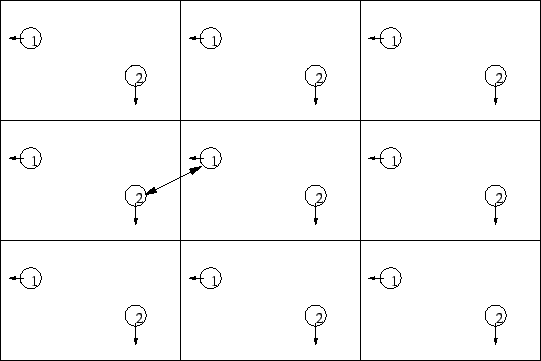 |
 |
Since the size of our system is typically 10-100 molecular diameters, this
is certainly not a good representation for a macroscopic sample because most
of the particles will be situated near a ``wall'' or ``boundary''. To
minimize the effects of the boundaries and to simulate more closely the
properties of the macroscopic system, it is convenient to choose ``periodic
boundary conditions''. These means that our basic box containing ![]() particles is surrounded by images (or replicas) of itself. This is
equivalent to wrap the coordinates around the boundaries: when one particles
hits a wall, instead of bouncing pack, it reappears on the other side of the
box. This means that the system has the topology of a torus. If the linear
size of the box is
particles is surrounded by images (or replicas) of itself. This is
equivalent to wrap the coordinates around the boundaries: when one particles
hits a wall, instead of bouncing pack, it reappears on the other side of the
box. This means that the system has the topology of a torus. If the linear
size of the box is ![]() , the maximum separation between particles is
, the maximum separation between particles is ![]() .
.
The rule can be summarized as follows: instead of the coordinate ![]() of
some particle, we have to adopt
of
some particle, we have to adopt
To compute the potential energy or the force between two particles ![]() and
and ![]() one augments the periodic boundary conditions we have to adopt the
so-called ``nearest image convention''. Imagine that the two particles on
opposite sides of the box. The convention dictates that we have to adopt the
minimum distance across the walls, or between images in the neighboring
replicas. If
one augments the periodic boundary conditions we have to adopt the
so-called ``nearest image convention''. Imagine that the two particles on
opposite sides of the box. The convention dictates that we have to adopt the
minimum distance across the walls, or between images in the neighboring
replicas. If
![]() is larger than
is larger than ![]() , then the
particle
, then the
particle ![]() will be disregarded as an interaction partner of
will be disregarded as an interaction partner of ![]() , with its
left image, having coordinate
, with its
left image, having coordinate ![]() in its place. In practice this means
simply that when calculating
in its place. In practice this means
simply that when calculating ![]() we have to use the quantity
we have to use the quantity
![]() instead of
instead of ![]() . An analogous rule holds for
. An analogous rule holds for
![]() and for the other coordinates.
and for the other coordinates.
The rule can be expressed by
Expressions (44) and (43) can be replaced by ifs expressions. In a parallel code this is counter productive, but in a serial code may be preferable. The optimal choice should be base on benchmarks.